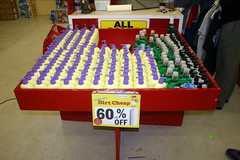The latest addition to the history of hip-hop odes to products, sneakers in particular, is “Vans,” by Bay Area rap group The Wolfpack, or just The Pack. (Here’s the group’s MySpace page — the song starts playing as soon as you arrive, and it’s laced with profanity, so, you know, click with care.) It’s about how great Vans are, and how they’ve always been great, and how you should throw out your Nikes, and so on. But that’s not what’s interesting.
What’s interesting is that somebody called Drino Man has responded with an answer remix about how much he hates Vans. In fact his track is called “Fuck Vans.” Nikes and Jordans, among others, are declared “real sneakers,” and Vans are … well, I guess the title pretty much sums up where this guy is coming from. Here’s his Myspace page; the lyrics are quite obscene, so, you know, you’ve been warned.
I don’t think either song is particularly good, but that’s hardly the point, is it? I’m slightly interested in whether Vans will do anything with or about all of this (or whether they’ve orchestrated the whole thing somehow), and also in whether marketing guru types will pick up on it as another example of technology “empowering” consumers to “join the conversation.” Assuming, of course, that bickering about sneaker brands counts as a “conversation.”
I heard about this by way of The Weekly Drop. The Pack’s pro-Vans song is also discussed at ProHipHop.com.
New Era/Gabriel Urist Chain: A cap manufacturer’s evolution into a fashionable brand.
While it may not seem obvious at first, there’s something almost inevitable about the creation of a $525 platinum baseball-cap pendant necklace. Although, to sell at that price, it can’t be just any necklace, and it can’t be based on just any baseball cap: it requires collaboration — something that both brands and artists have become increasingly interested in. Thus the Gabriel Urist New Era pendant necklace offers not so much a strange aberration as a small case study of how such projects can come about….
Continue reading at the NYT Magazine site by way of this no-registration-required link.
Related links:
Also worth reading in the NYT Mag this week: Michael Pollan’s lucid and well-informed overview of the pros and cons of Wal-Mart getting into the “organics” business.


Photographs via Flickr by kate*
It’s just about impossible to pick one favorite image from this Flickr set from a store called Hudson’s Dirt Cheap. It’s by Kate “Obsessive Consumption” Bingaman.
It’s particularly interesting as a kind of counterpoint to the photographs that Andreas Gursky took at 99 Cents Only stores: Those have a feeling of spectacular, almost sickening abundance. I’ve seen some of them in person, and the monumental scale adds to the effect. There’s a bit of a different feel to this, but I think you’ll see the connection, and why these work as a counterpoint. I was interested to discover, in the course of trying to remember Gursky’s name, that 99 Cents Only, which is a chain, actually uses one of his images on its home page.
Firefox Flicks: What does it mean when consumers become producers – of advertising?
Advertising was called the “folklore of industrial society” as early as the 1950’s, when Marshall McLuhan used that phrase. Back then, though, the tools required to fashion and disseminate the images and stories of industrial products to the masses were available only to industry (or rather to the advertising agencies hired by industry). Today the folk — or at least much of the middle class — have those tools, too, and in recent years have shown a surprising willingness to use them on behalf of brands. Converse has solicited consumer-made commercials for a couple of years and has received more than a thousand; lately General Motors, MasterCard and others have asked for, and received, contributions to their marketing efforts from the grass roots. Perhaps the most famous consumer-created ad — a computer animation of flying iPods made by a California teacher — was made and distributed without any input from the makers of the product. It makes sense that Firefox, the Web browser distributed by the Mozilla Corporation, would try this approach …
Continue reading at the NYT Magazine site by way of this no-registration-required link.
Related links:
Also, not related, but in the NYT Magazine this week and worth reading: Randy Kennedy’s article about MTV making shows for cellphones, and Scott Anderson’s cover story on National Guardsmen re-adjusting to civilian life after tours in Iraq. On the latter subject, this recent episode of public-radio show Speaking of Faith is also worthwhile.
Very early on in the brief history of “Consumed,” I wrote about the Treo, I think it was the Treo 600 back then. The other day there was an interesting Q&A in the WSJ with Ed Collligan, CEO of the company that makes the Treo. Here’s the bit I liked:
WSJ: How are consumers actually using their mobile devices?
Mr. Colligan: The only thing that surprises me consistently is how little they use the devices. There is so much capability that 90% of people don’t discover. They say, “It would be really cool if you had a MP3 player in here.” We do.
Many people use the Treo as a phone. People come to me all the time and say, “I love this thing, it has changed my life. I just run my whole life with it.” I’ll get their device and I’ll go into it. They have 12 addresses in it and a few appointments. … Essentially, the devices are almost too complex for a lot of people. And it is one of our challenges.
We hear so much about the demanding and super-savvy consumer, it always makes me chuckle to hear the actual reports from the front lines of commerce that, in fact, people aren’t even mastering the devices they already own. I don’t know how much more blatantly that can be expressed than in the form of consumers asking for functionality that already exists.
And yet: Does it matter? I suspect people want the most awesomely functional device even if something simpler (and cheaper) would actually do the trick. Maybe 12 addresses and a few appointments are all that some of us need to keep track of, Colligan’s exasperation notwithstanding. But there’s still something appealing in the idea of owning all that hyper-functionality: “conspicuous utility” is the phrase I used in “Consumed.” Or maybe some people are attracted by one bit of the functionality, don’t care about the rest, and would rather just spring for the well-known device and keep alive the vague hope that some day they’ll exploit its full powers, rather than spend a lot of time and effort researching the optimum choice.
Either way, maybe Colligan shouldn’t be annoyed or bummed out that consumers aren’t as clever as they could be. Maybe, considering that they’re buying his device anyway, he should be really, really happy.
Posted Under:
Consumer Behavior by Rob Walker on May 27, 2006
Comments Off on Treo: “Too complex”?
Flickr is thoroughly, consistently fascinating. And lurking about in its endless depths are plenty of images that in one way or another relate to brands, products, consumption, and material culture. Here, for example, is one of many Flickr images of the recent Apple store opening in Manhattan.
I got to this particular set by way of an extremely detailed report from someone who arrived at the new store on Tuesday (to wait for the actual opening … on Saturday.) If you want all the details on who those people were who waited on the street for several days in order to visit a retail location, well, you have your link. The highlight: “With just 15 minutes left before opening,” one guy in the line, named Steve, ” turned to his girlfriend Patti and proposed to her. She accepted, and that set off a ripple of ‘Awwww’ back through the crowd, and up to the Apple staffers.”
Great story to tell the kids. Anyway, the site containing that report is ifo AppleStore: News and Information About Apple Computer’s Retail Stores. I ended up there by way of a link from this Wired News report: “Fans Storm Apple’s 5th Avenue Store.” Another account, from one of the Apple fans pictured above, can be found on her blog.
Buildings of Disaster: What a collection of disaster-themed souvenirs says about design, commerce and taste.
Not long after Hurricane Katrina, Constantin Boym was reading a news article that referred to the New Orleans Superdome as “a symbol of all that went wrong” on the Gulf Coast before, during and after the storm. When he read that, he says, he realized that the sports stadium now stood for something quite different from — and much larger than — its intended function. “It stood for that terrible event, that historical event,” he says. And that made it an appropriate addition to “Buildings of Disaster,” a series of “souvenirs” produced and distributed by his design studio, Boym Partners. …
Continue reading at the NYT site via this no-registration-required link.
Related link:
The Blackspot: A brand that appeals to the toughest consumers — the ones who are sick of brands.
“Dylan Coyle, who is 24, studies music at San Francisco State University. He has been a vegan for five years and is a careful consumer. Last year, somebody asked him what he wanted for Christmas, and he said he wanted a pair of Blackspot shoes. This was a considered choice: the shoes are made from ‘vegetarian materials,’ including organic hemp and recycled tires. They are manufactured in a ‘safe, comfortable union factory’ in Portugal and sold by the creators of Adbusters, a magazine best known for its withering critique of the advertising business and of mindless materialism….”
[To continue reading at NYT Magazine, follow this registration-free link.]
Related links:
[Yellow Tail Wine]
For a shortcut, clichéd summation of growing consumer sophistication, consider the wine category: Back when we didn’t know anything, wine meant Blue Nun, jugs of Gallo, little bottles of Lancers and hokey Aldo Cella commercials. Nowadays we have taste, and even suburban megamarts have huge and varied wine selections for the demanding mass affluent. Of course, real wine connoisseurs have walked the earth for many years — as have nonconnoisseurs who find such people to be annoying snobs and who find today’s megamart selection to be a big, bewildering taunt. It’s one thing to sense that there’s a huge spectrum of quality represented on that shelf, but it’s something else to make a decision. Perhaps, in light of this, it’s no surprise that a new factor has emerged that apparently helps many of us parse the options: the “critter label.”
A critter label is any label that features an animal, from a hippo to a frog to a penguin. According to ACNielsen, the market-research company, 438 viable table-wine brands have been introduced in the past three years, and 18 percent — nearly one in five — feature an animal on the label. “Combined with existing critter labels,” the firm said in a summation of its research on this matter, “sales of critter-branded wine have reached more than $600 million.”
Please continue…
Posted Under:
Consumed,
Wine Packaging by Rob Walker on April 23, 2006
Comments Off on Archival Consumed: Animal Pragmatism
[Supreme]
The relationship between high fashion and street wear goes back a long way. In a recent book called “The Essence of Style,” by Joan DeJean, there is an anecdote from the spring of 1677, when “an inexpensive gray serge cloth” worn by Parisian shopgirls was adapted by “ladies of the court” who liked the fabric’s look and incorporated it into their elegant wardrobes. This is how it has seemed to work ever since — right up through the archetypal example of the “grunge” style associated with the Seattle music scene appearing on the runways, courtesy of the designer Marc Jacobs (then working for Perry Ellis) in the early 1990’s. In other words, the streets are raided for ideas and inspiration that get reworked in a couture context — “the aura of wealth and luxury,” as DeJean wrote of the 17th-century version of the high-low mash-up.
All of this implies tension between street populism and couture exclusivity. But in the last few years, as some sneaker shops have come to resemble highfalutin art galleries, it has been a little less clear who is borrowing what from whom. Consider, for example, Supreme. Please continue…
Station Exchange
Back in 2001, a professor named Edward Castronova began to study the way markets worked in a place called Norrath. Norrath does not exist in a physical sense but is the name of the “virtual world” where the online computer game EverQuest is set. EverQuest is filled with half-elves, castles, sword fights and such, and also involves a fairly complex internal economy, whose currency is platinum pieces used to buy weapons, food and other goods. Although the goods are digital, it’s not quite right to say that they don’t have real value; pretty much from the earliest days of Norrath, Castronova discovered, game players found ways to pay real-world dollars for fake-world things. Please continue…
[ Silent Treatment ]
The adoration of the outlaw is a durable feature of American culture, giving us romantic images of authority-defying individuals from Billy the Kid to Tony Soprano. And maybe this attraction has something to do with the recent and rather controversial success of a Boston clothier called Antonio Ansaldi, which has sold more than 10,000 T-shirts featuring a big red stop sign and the slogan “Stop Snitchin’.” Please continue…
[Club Libby Lu]
Whether we want to admit it or not, Mary Drolet argues, there was a time in our lives when we all pretended to be rock stars or princesses. That time was childhood, the years before the line between fantasy and reality becomes more tangible. This belief, in part, is what guided Drolet in founding, with two partners, a business called Club Libby Lu, which offers 5- to 13-year-old girls the chance to live out one of several (overtly girlish) fantasies, at least for the duration of an hour-and-a-half-long party in a shopping mall.
Club Libby Lu is what’s known as an ”experience” retailer, meaning that it sells a kind of packaged happening rather than just products. There are plenty of examples of the mammoth store-as-spectacle approach (the American Girl Place locations in Chicago and New York City, or the outdoor-gear seller Cabela’s), but Club Libby Lu was always meant for malls, and it has locations in 77 of them now, with 8 more on the way by the end of the year.
Please continue…
Posted Under:
Consumed by Rob Walker on August 21, 2005
Comments Off on Archival Consumed: The Princess Factory
[ Splenda ]
Sugar is one of those commodities that seem so commonplace that it is hard to imagine their absence. This was not always so: it was once a rare luxury, but a few hundred years of globalization and industrialization, plus some colonization and slavery, helped change that. Not that there weren’t always critics, of course. ”Sugar hath now succeeded honie,” the author of one quasi-medical book wrote in 1633, ”and is become of farre higher esteem, and is far more pleasing to the palat” — before questioning the view, not uncommon at the time, that sugar had medicinal properties and charging that it ”heateth the blood” and ”rotteth the teeth,” among other things. Several centuries on, of course, sugar is something that many people try to cut back on, or eliminate from their diets altogether. But sweetness is something few can do without, which means that there has been a vigorous market for sugar substitutes, from Sweet ‘N Low to Equal to, more recently, Splenda.
Please continue…
Posted Under:
Consumed,
Uncategorized by Rob Walker on March 13, 2005
Comments Off on Archival Consumed: Sticky Success
A great deal of attention and study have been devoted to individuals who, as a result of feeling marginalized by mainstream culture, adopt a recognizable visual look and form a new social group. Take the 1979 book ”Subculture: The Meaning of Style,” in which Dick Hebdige deconstructed punks, mods, teddy boys and others. Hebdige called them ”spectacular subcultures,” and his observations apply to any number of groups, from goths to skateboarders to b-boys. Communicating ”significant difference,” as well as group identity, Hebdige wrote, ”is the ‘point’ behind the style of all spectacular subcultures.” It almost goes without saying that nearly all of these groups were and are made up of young people, and that these days much of the studying is done by marketers, professional trend-spotters and a huge chunk of the entertainment industry. Please continue…
Posted Under:
Consumed by Rob Walker on January 30, 2005
Comments Off on Archival Consumed: Red Hat Society




 "
"















 Kim Fellner's book
Kim Fellner's book  A
A